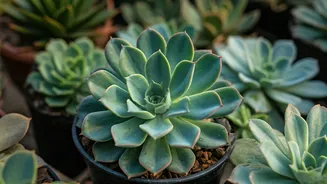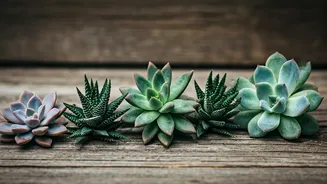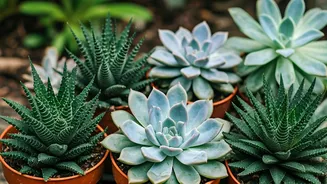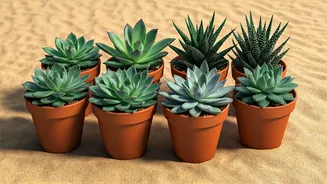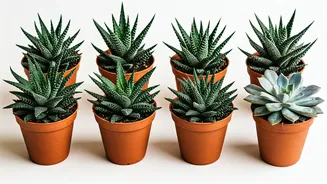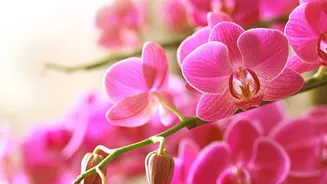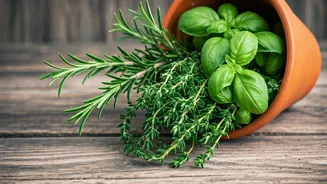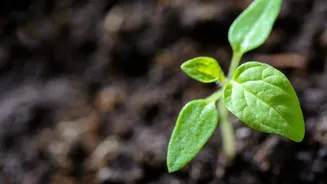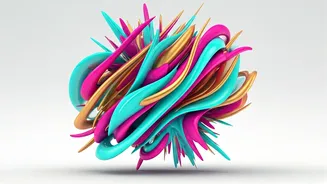Sempervivum (Houseleeks)
Sempervivum, commonly known as houseleeks, are renowned for their incredible hardiness. These succulents are capable of enduring extreme conditions and
are often seen thriving on rooftops and in rock gardens. These plants are exceptionally resilient and can live for more than 50 years, given proper care. They get their name from their ability to spread, with the mother plant producing numerous offsets, often called 'chicks'. They are well-suited to various environments and demonstrate a low maintenance requirement. They require well-draining soil and plenty of sunlight, while they are also drought-tolerant. They are a favored choice for those seeking a durable, long-lasting plant with minimal effort, making them popular for beginners.
Agave: Majestic Plants
Agave plants are another group of long-living succulents, renowned for their striking appearance. Certain agave species can live for several decades, even up to a century in some cases. These succulents are characterized by their large, often spiky, leaves that form a rosette shape. Agaves are native to the Americas and come in various sizes and forms. Their lifespan is affected by factors like species, environment, and care. They need well-draining soil and a lot of sunlight, and they are drought-resistant once established. Although agave plants are low-maintenance, they have very specific care guidelines. The impressive lifespan and architectural appeal of the agave make it a sought-after plant for landscape design, bringing a touch of architectural interest to gardens and landscapes.
Aloe: Medicinal and Durable
Aloe plants are not only valued for their medicinal properties but also for their impressive longevity. Several species of aloe can live for 50 years or more. These succulents are characterized by their thick, fleshy leaves filled with a gel used for soothing burns and other skin irritations. Native to Africa, aloe plants adapt well to different environments, from arid deserts to more humid climates. They favor well-draining soil and thrive in bright light. Their hardiness and ability to thrive in various conditions make them an excellent choice for beginner gardeners. The aloe's combination of beauty, health benefits, and longevity makes it a great choice.
Echeveria: Colorful Rosettes
Echeveria succulents are celebrated for their diverse forms and vibrant colors. Though smaller compared to some of the other long-lived succulents, echeverias can still endure for several years, often living for more than 10 to 20 years, provided the right conditions. These succulents display rosette-shaped leaves, offering a spectrum of colors from green to red and purple. Echeverias require well-draining soil, bright sunlight, and moderate watering. Their adaptable nature allows them to flourish both indoors and outdoors. Echeverias are also quite easy to propagate, further adding to their appeal. Their beauty and low maintenance needs make them perfect for gardens or as decorative houseplants, enhancing any space.
Sedum: Groundcover and Height
Sedum, also known as stonecrop, is a varied genus, which includes both ground cover varieties and taller, upright species. Many Sedum varieties are impressively long-lived, often thriving for several decades. These succulents are valued for their diverse forms, from low-growing ground covers to taller, flowering types. Sedums are known for their resilience and require minimal maintenance, flourishing in full sunlight and well-draining soil. They are highly adaptable and drought-tolerant once established. Sedums' adaptability and aesthetic appeal make them suitable for various garden settings. From rock gardens to green roofs, sedums offer both beauty and long-term performance, making them a great choice for both novice and seasoned gardeners.
Crassula: The Jade Plant
Crassula, most famously represented by the jade plant (Crassula ovata), is a widely recognized succulent known for its longevity and attractive appearance. Jade plants can easily live for 50 years or more, and some specimens have been reported to live for a century or more with excellent care. Jade plants are easily identified by their thick, fleshy, oval-shaped leaves and woody stems. They are native to South Africa and are favored as indoor plants. These plants are relatively low-maintenance, needing well-draining soil, bright sunlight, and infrequent watering. They are known for their ability to be easily propagated from leaf or stem cuttings. The jade plant is a classic choice for indoor gardeners, combining elegance with a long lifespan.
